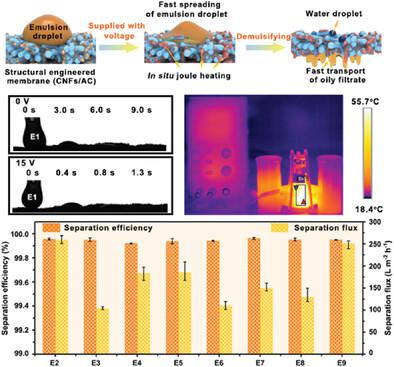当前位置:
X-MOL 学术
›
Small Methods
›
论文详情
Our official English website, www.x-mol.net, welcomes your
feedback! (Note: you will need to create a separate account there.)
Structural Engineering-Enabled Joule Heating Effect Cooperated with Capillary Effect Toward Fast Spreading of Droplets for High-Flux Separation of Viscous Emulsion
Small Methods ( IF 10.7 ) Pub Date : 2023-08-02 , DOI: 10.1002/smtd.202300513 Yiran Cao 1, 2 , Wan Zheng 2 , Baicun Hao 1 , Hanzhong Xiao 1 , Yiwen Cui 1 , Xin Huang 1, 2 , Bi Shi 1, 2
Small Methods ( IF 10.7 ) Pub Date : 2023-08-02 , DOI: 10.1002/smtd.202300513 Yiran Cao 1, 2 , Wan Zheng 2 , Baicun Hao 1 , Hanzhong Xiao 1 , Yiwen Cui 1 , Xin Huang 1, 2 , Bi Shi 1, 2
Affiliation

|
Viscous emulsions with poor fluidity and high adhesion are extremely difficult to separate. Herein, high-flux separation of viscous emulsions is realized by developing structural engineered collagen fibers (CFs)-based composite membrane that featured 3D conductive hierarchical fiber structure with the spaced carbon nanofibers (CNFs) and activated carbon (AC) serving as conductive network and competitive adsorption-based demulsifying sites, respectively. The as-designed membrane structure boosts fast spreading of emulsion droplets on membrane surface aided by the synergistic effect of joule heat in situ generated by the spaced CNFs and the capillary effect derived from CFs, which guarantees the full contact of viscous emulsions with the spaced AC for achieving ultra-efficient demulsifying. The permeation of resultant oily filtrate is accelerated by the capillary effect of hierarchically fibrous structured CFs to exhibit fast transport kinetics, therefore accomplishing high-flux separation. The structural engineered membrane achieves high-performance separation toward different viscous emulsions (55.4-123.7 mPa·s) with separation efficiency >99.9% and flux high up to 259 L m−2 h−1. The investigations provide a novel structural engineering strategy for realizing high-performance separation of viscous emulsions.
中文翻译:

结构工程实现的焦耳热效应与毛细管效应相结合,实现液滴的快速扩散,实现粘性乳液的高通量分离
流动性差、附着力高的粘稠乳液极难分离。在此,通过开发基于结构工程胶原纤维(CF)的复合膜实现了粘性乳液的高通量分离,该复合膜具有3D导电分层纤维结构,以间隔的碳纳米纤维(CNF)和活性炭(AC)作为导电网络和分别基于竞争吸附的破乳位点。设计的膜结构借助间隔的CNF原位产生的焦耳热和CF的毛细管效应的协同效应,促进乳液液滴在膜表面的快速铺展,保证了粘性乳液与间隔的AC的充分接触以实现超高效破乳。分级纤维结构CF的毛细管效应加速了所得油性滤液的渗透,从而表现出快速传输动力学,从而实现高通量分离。该结构工程膜对不同粘稠乳液(55.4-123.7 mPa·s)实现了高性能分离,分离效率>99.9%,通量高达259 L m -2 h -1。该研究为实现粘性乳液的高性能分离提供了一种新颖的结构工程策略。
更新日期:2023-08-02
中文翻译:

结构工程实现的焦耳热效应与毛细管效应相结合,实现液滴的快速扩散,实现粘性乳液的高通量分离
流动性差、附着力高的粘稠乳液极难分离。在此,通过开发基于结构工程胶原纤维(CF)的复合膜实现了粘性乳液的高通量分离,该复合膜具有3D导电分层纤维结构,以间隔的碳纳米纤维(CNF)和活性炭(AC)作为导电网络和分别基于竞争吸附的破乳位点。设计的膜结构借助间隔的CNF原位产生的焦耳热和CF的毛细管效应的协同效应,促进乳液液滴在膜表面的快速铺展,保证了粘性乳液与间隔的AC的充分接触以实现超高效破乳。分级纤维结构CF的毛细管效应加速了所得油性滤液的渗透,从而表现出快速传输动力学,从而实现高通量分离。该结构工程膜对不同粘稠乳液(55.4-123.7 mPa·s)实现了高性能分离,分离效率>99.9%,通量高达259 L m -2 h -1。该研究为实现粘性乳液的高性能分离提供了一种新颖的结构工程策略。




















































 京公网安备 11010802027423号
京公网安备 11010802027423号